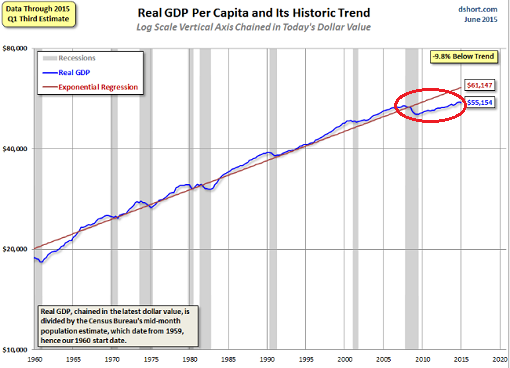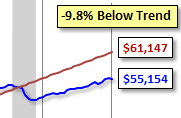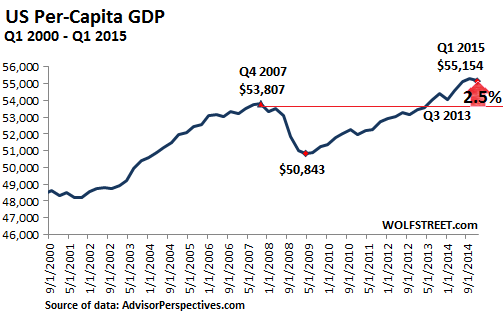Evidence is piling up that the US economy is muddling through, rather than falling off a cliff.
The first quarter was bad, but the Third Estimate of first-quarter GDP, released on Wednesday, showed that it was still bad (-0.2%), but not as bad as feared after the Second Estimate (-0.7%). Data for the current quarter has been mixed, as they say, but better, pointing at the same pace of growth the economy has been experiencing for years, a frustratingly slow pace, not anywhere near the much hyped but always elusive “escape velocity.”
However, there are pronounced booms in parts of the country, including in the Bay Area and Silicon Valley. For people that participate in these booms in one way or another, it can be a thrilling experience, with money sloshing through the streets knee-deep. Elsewhere, it doesn’t look so hot, and people there still think we’re in a recession because to them, it feels like we’re in a recession – or have never left the recession behind in the first place.
Turns out, they have good reason to feel that way.
On Tuesday, I wrote about Durable Goods orders, which had been, as I said, “lousy, lousy, lousy.” But when adjusted for inflation and population growth, they’d been terrible, not just for the month, but for years, down 36.5% per-capita from their peak in 2000!
This “per capita” is closer to what we as individuals experience. I wrote, “If you have a bigger pie, but you slice it into more pieces, each piece might end up being smaller.” And many people are getting a smaller slice than they did before the Financial Crisis.
The same principle in a much broader manner applies to GDP. Doug Short at Advisor Perspectives has a great series on per-capita GDP. It sheds more light on the discussion of how this economy feels than all the hoopla from Wall Street economists put together. Here’s what that looks like on Doug’s chart (log scale) in current dollars going back to 1960:
The trend line (red) shows an unnerving reality.
During the Financial Crisis (the big-fat gray bar), per-capita GDP fell off a cliff but then never returned to trend. In fact, the gap to the trend line has been slowly widening since. By Q1 2015, per-capita GDP was 9.8% below trend. To the left is the detail from the above chart.
The same data in more granular detail shows just how bad it has been. Per-Capita GDP, in today’s dollars (adjusted for inflation), hit a pre-Financial Crisis high of $53,807 in Q4 2007, plunged to $50,843 in Q2 2009 as the economy hit bottomed after its tailspin, then gradually began to recover. Since the US population increased as well, the real economic growth per-capita was minuscule, interrupted by a number of down-quarters:
The big hole in per-capita GDP lasted from the peak of per-capita GDP in Q4 2007 all the way to Q3 2013, when it finally returned to the same level as six years earlier. By Q1 2015, it was up a measly 2.5% from where it had been in Q4 2007. But 2.5% growth spread over 8 years is a rounding error in history. And if inflation calculations underestimate actual inflation by even tiny increments every year – and that’s not such a far-fetched possibility – the whole thing turns negative.
It’s even worse for a lot of people. Much of that growth occurred in certain areas of the country and was concentrated on some sectors, such as tech or the fracking boom. In many other areas, per-capita GDP actually declined.
That 2.5% growth spread over eight years is so diminutive that a recession much smaller than the Financial Crisis may drive per-capita GDP back below where it had been in 2007. And this, after seven years of scorched-earth monetary policies that have inflated asset prices to ludicrous levels and have produced the greatest credit bubble in history, but not a heck of a lot of economic growth.
Enjoy reading WOLF STREET and want to support it? You can donate. I appreciate it immensely. Click on the mug to find out how:
![]()





Wolf thanks for this post but I can simplify your message. The crucial thing to understand is that this economy died in 2007. There is no real recovery.
What you are describing seems pretty accurate to me, but the “real picture” is probably even bleaker. No one eats GDP per capita. What people have is income. And for most of us, this means wages. And with the share of GDP going to wages at historic lows (https://research.stlouisfed.org/fred2/graph/?g=2Xa), and that depressingly low amount getting increasingly to a smaller number of people, the real median income is probably not even recovering.
Any “GDP” calculation – and anything derived from them – is meaningless.
With vast counterfeiting (“expansion of the supply of money and credit”) having gone on now for decades, it is likely that a goodly portion of what is always assumed to be “economic growth” actually consists of cheap money-dependent misallocations of capital.
How do we know what is real, sustainable and economically justified and what is fluff, dependent on continuing expansion of credit?
Millions of people’s jobs. Numerous businesses and business models: RV sellers, poodle groomers, salad shooters. No-cash-flow companies. Zombie enterprises. Insolvent governments and their “infrastructure spending” plans (see Japan’s “bridges to nowhere”). All public companies which do not generate revenue in excess of costs. And don’t forget driving schools, lawyers, notaries, (mandatory) smoke alarm manufacturers, renters to welfare recipient tenants, dentists whose business consists largely of treating Medicaid patients, physiotherapists doing likewise. And so on…
HELL of a “productive economy”. We’re in a hall of mirrors and nothing is real. One day this must collapse BIG TIME.
It collapsed in 2008. What you’re seeing now are the parts falling off. Think slow motion train wreck. That is a process that takes place over decades, not in a day. cf. Japan.